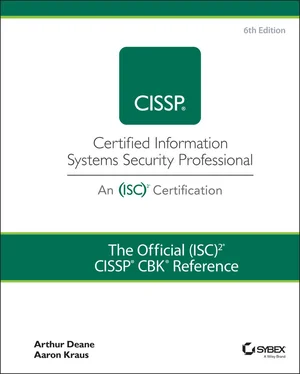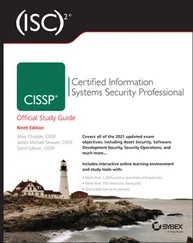As a CISSP, you should be familiar with the following global cybercrime and information security laws and regulations:
U.S. Computer Fraud and Abuse Act of 1986
U.S. Electronic Communications Privacy Act (ECPA) of 1986
U.S. Economic Espionage Act of 1996
U.S. Child Pornography Prevention Act of 1996
U.S. Identity Theft and Assumption Deterrence Act of 1998
USA PATRIOT Act of 2001
U.S. Homeland Security Act of 2002
U.S. Controlling the Assault of Non-Solicited Pornography and Marketing (CAN-SPAM) Act of 2003
U.S. Intelligence Reform and Terrorism Prevention Act of 2004
The Council of Europe's Convention on Cybercrime of 2001
The Computer Misuse Act 1990 (U.K.)
Information Technology Act of 2000 (India)
Cybercrime Act 2001 (Australia)
NOTEMany of the regulations in this section have been around for decades. While most of them are still relevant as of this book's writing, the legal landscape is dynamic and changes every year.
U.S. Computer Fraud and Abuse Act of 1986, 18 U.S.C. § 1030
The U.S. Computer Fraud and Abuse Act of 1986 is the oldest and, yet, still possibly the most relevant cybercrime law currently in effect in the United States. The law has been revised over the years, and you should be familiar with both its original form and the revisions discussed in this section.
The Computer Fraud and Abuse Act (CFAA) is a cybercrime bill that was enacted in 1986 as an amendment to the Comprehensive Crime Control Act of 1984. The CFAA was created to clarify definitions of computer fraud and abuse and to extend existing law to include intangible property such as computer data. Although the CFAA now covers all computing devices, the original law was written to cover “federal interest computers” — a term that was changed to “protected computers” in a 1996 amendment to the act. Section 1030(e)(2) defines a protected computer as one that is
“[E]xclusively for the use of a financial institution or the United States Government, or, in the case of a computer not exclusively for such use, used by or for a financial institution or the United States Government and the conduct constituting the offense affects that use by or for the financial institution or the Government”
“[U]sed in or affecting interstate or foreign commerce or communication”
In plain English, a protected computer is a computer used by the U.S. government or financial institutions, or one used for interstate and foreign communications and financial transactions. It's important to note here that this definition is broad enough to apply to any computer that is “used in or affecting” government and commerce — a computer does not need to be directly used or targeted by a cybercriminal to be considered protected under this definition.
The CFAA establishes seven criminal offenses related to computer fraud and abuse and identifies the penalties for each:
Obtaining national security information: §1030(a)(1) describes the felony act of knowingly accessing a computer without or in excess of authorization, obtaining national security or foreign relations information, and willfully retaining or transmitting that information to an unauthorized party.
Accessing a computer and obtaining information: §1030(a)(2) describes the misdemeanor act of intentionally accessing a computer without or in excess of authorization and obtaining information from a protected computer. This crime is upgraded to a felony if the act is committed to gain commercial advantage or private financial gain, if the act is committed in furtherance of any other criminal or tortious act, or if the value of the obtained information exceeds $5,000.
Trespassing in a government computer: §1030(a)(3) extends the definition of trespassing to the computing world and describes a misdemeanor act of intentionally accessing a nonpublic protected computer, without authorization, and affecting the use of that computer by or for the U.S. government. §1030(a)(2) applies to many of that same cases that §1030(a)(3) could be charged, but §1030(a)(2) may be charged even when no information is obtained from the computer. In other words, section 1030(a)(3) protects against simply trespassing into a protected computer, with or without information theft.
Accessing to defraud and obtain value: §1030(a)(4) was a key addition to the 1984 act, and it describes the felony act of knowingly accessing a protected computer without or in excess of authorization with the intent to fraud. Under §1030(a)(4), the criminal must obtain anything of value, including use of the information if its value exceeds $5,000. The key factor with §1030(a)(4) is that it allows information theft (described in §1030(a)(2)) to be prosecuted as a felony if there is evidence of fraud.
Damaging a computer or information: §1030(a)(5) was originally written to describe the felony act associated with altering, damaging, or destroying a protected computer or its information, or preventing authorized use of the computer or information, such that it results in an aggregate loss of $1,000 or more during a one-year period. This provision was later rewritten and now more generally describes a misdemeanor act associated with knowingly and intentionally causing damage to a computer or information. §1030(a)(5) upgrades the crime to a felony if the damage results in losses of $5,000 or more during one year, modifies medical care of a person, causes physical injury, threatens public health or safety, damages systems used for administration of justice or national security, or if the damage affects 10 or more protected computers within 1 year.
Trafficking in passwords: §1030(a)(6) establishes a misdemeanor and prohibits a person from intentionally trafficking computer passwords or similar information when such trafficking affects interstate or foreign commerce or permits unauthorized access to computers used by or for the United States. The term traffic here means to illegally transfer or obtain control of a password with the intent to transfer it to another party. This definition is important because it excludes mere possession of passwords if there is no intent to transfer them.
Threatening to damage a computer: §1030(a)(7) describes a felony offense associated with the computer variation of old-fashioned extortion. This provision prohibits threats to damage a protected computer or threats to obtain or reveal confidential information without or in excess of authorization with intent to extort money or anything else of value.
The U.S. Computer Fraud and Abuse Act of 1986 has seen numerous amendments over time, both directly and through other legislations. Minor amendments were made in 1988, 1989, and 1999, with major amendments being issued in 1994, 1996, and 2001 through various other acts discussed later in this chapter.
U.S. Electronic Communications Privacy Act of 1986
The Electronic Communications Privacy Act (ECPA) was enacted by the U.S. Congress in 1986 to extend restrictions on government wire taps to include computer and network-based communications (rather than just telephone calls). The ECPA complements the CFAA by prohibiting eavesdropping, interception, and unauthorized monitoring of all electronic communications (including those sent over computer networks).
The ECPA does, however, make certain exceptions that allow communications providers (like an ISP) to monitor their networks for legitimate business reasons if they first notify their users of the monitoring. This sets up a legal basis for network monitoring, which has been criticized over the years. The USA PATRIOT Act (discussed in a later section) made several extensive amendments to the ECPA in 2001.
U.S. Economic Espionage Act of 1996
Читать дальше












